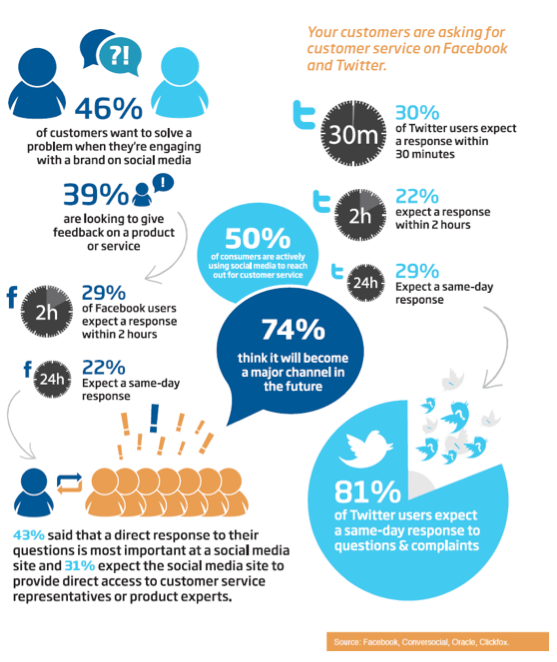Understanding what causes customer disasters on social media can help you avoid them completely. Smart social customer care is about aligning with the customer throughout their journeys, not just when crisis occurs.
However, there are several typical ways social customer service disappoints. How are you doing in these situations?
5 Ways Social Customer Service Is Disappointing Customers
1. Not responding fast enough!
According to a report from Social Business News, 81% - 90% of Twitter users expect same-day responses to questions and complaints. Where do they go if they don’t receive a fast response? They complain to others in their network, spreading negative reviews. If customers are asking for help, they expect the brand’s social media channels to help them gain immediate access to answers and support. Responding several hours later or worse, not at all, sets up not just the one customer for bad feelings, but everyone he or she communicates with about the situation.

Source: Social Business News
RELATED CLASS: Crisis Management with Social Media
2. Promoting the old fashioned way.
Understanding the medium is just as important as being there in the first place. Facebook, for example, should not be just a place to promote your sales, and yet that’s what many brands do there. Producing boring customer service videos for your YouTube channel doesn’t win any fans. Instead, approach each channel with a creative eye. The way some brands are using social media to creatively and uniquely interact with fans and customers creates loyalty and extremely popular and positive word-of-mouth traction. Take a page from the "Most Interesting Man In The World" campaign from Dos Equis and create fun to help serve customers.

3. Lazy replies!
Using Twitter to answer thousands of unique customer inquiries by pointing them all to the same, difficult-to-navigate Frequently Asked Questions section of the corporate web site doesn’t really serve customers. It lacks real care or communication. Customers see right through this, feeling duped by the reply to their very real question. It’s also important to avoid the “thanks for the feedback” standard response when no action is promised or taken. People love dealing with real people through these channels, so it’s critical to be human in your responses, not robotic.
RELATED CLASS: Twitter Tactics for Higher Engagement & ROI
4. Never featuring customers.
Customers who love your brand should be rewarded. If they are using your products to create recipes they pin to Pinterest boards or mentioning their love for your brand on Twitter, it seems disingenuous to ignore it. Featuring customers, and what they’re doing with your products, is a wonderful way to “show the love.” Brands that don’t acknowledge the very people who made them successful seem aloof and indifferent. Don’t make that mistake!
5. Not providing access to experts.
In that same report from Social Business News, they found 31% of social customers want direct access to product experts. If customer service reps are isolated from the rest of the business, this becomes an impossible request. Customers want to know the right people are answering their questions and concerns via social media. Providing “ask an expert” channels helps customers feel they have access directly to the source, instead of submitting a question via a faceless email form on the web site or calling a customer service number only to be transferred and told “this isn’t the right way to ask.”
RELATED CLASS: The Digital Marketer's Guide to Mastering Search and Social Media
The best brands provide insight into not just what makes the products special, but what makes the company special from the inside-out. Revealing the expertise behind the brand is part of that conversation.
Customers have higher demands and increased expectations for the companies they deal with over social media. Not meeting those expectations can lead to decreased loyalty, unfortunate word-of-mouth, and overall negative sentiment.
Turn a negative social media crisis into positive PR.
Watch Crisis Management with Social Media, and learn how to identify a social media crisis before it happens, how to plan for and recover from social media mishaps, and turn negative chatter into positive conversations. Plus, you'll see how 8 companies successfully handled a social media crisis—and how you can, too. Get instant access to this class now.